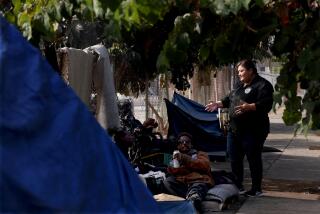East L.A. Residents Seek Help to Stop Crime : Violence: Projects’ group will ask Housing Authority for stepped-up police protection
The Pico Gardens housing project in East Los Angeles looked like a park Wednesday afternoon as toddlers frolicked on the swings, adults sipped punch and the American flag snapped in the breeze over the doorway of the Pico-Aliso Resident Advisory Council office.
“During the day it looks so quiet and peaceful, but at night we have problems,” said council member Pamela McDuffie, as she peered from the Spartan council office, an empty apartment provided by the City Housing Authority.
The problems at the project are the ones that dominate many of the city’s 21 housing projects: gangs, drugs and the violence they bring.
But residents in the city’s three sprawling, contiguous Eastside projects--Pico Gardens, Aliso Extension and Aliso Village--believe their situation is unique.
The 1,262-units in the three-project complex make it the largest in the city, McDuffie said. Twelve gangs claim the area as home turf, an unusually large number for one housing project, McDuffie said.
And violence is claiming innocent lives. There have been three homicides on the grounds in the last five months, she said, including the death of a 20-year-old pregnant woman, which particularly upset residents.
To counter what they consider a unique problem, the resident council spent five months devising its own solution, which members presented at a news conference in the project Wednesday.
The residents want the City Housing Authority to assign two of its 41 Housing Authority Police officers to the complex full time for foot patrols. The officers currently rotate among the 21 housing projects, with none assigned full time to any one.
The group also is seeking $25,000 for a youth anti-gang counselor who would steer project teen-agers back to school, toward jobs and away from crime and drugs.
“This is a job where, if I have it, I will work myself out of a job,” said Kenneth Wheler, a 29-year-old youth counselor picked by the residents to serve as counselor if the funds are approved.
The proposal, to be presented Friday to the seven-member Housing Authority board, represents a second surge of grass-roots independence and activism by the resident council in the East Los Angeles projects. Last month, the group secured a $53,000 HUD grant to study the feasibility of tenant management of the giant project. Four other HUD grants have been awarded tenant groups in the past two years for a total of $407,000.
“We’re planning to help ourselves but we need the assistance in doing so,” McDuffie said.
But that assistance may be difficult for the Housing Authority to provide.
Michelle Roth, a spokeswoman for the Housing Authority, said that no money is available for an anti-gang counselor in the authority’s $32-million 1990 project operating budget. The authority occasionally has sent teams into projects where gang violence has increased, but those were only temporary measures, she said.
In addition, the authority has only 41 police officers to patrol its projects spread from Pacoima to San Pedro. She said it is not likely the authority will be able to spare two officers full time for the East Los Angeles projects, but she said such decisions must be made by the board.
Marilyn Murphy, a 20-year-old who has lived half of her life in the projects, sees the resident council proposals as a step in the right direction.
Gang-related crime is causing life in the projects to spiral downward, she said.
“They sell drugs on the street, they speed by in cars and they crash their stolen cars,” she said.
Murphy does not permit her 2-year-old son, Christopher, to play in the front yard for fear that he may get hurt when cars driven by gang members speed by. She also keeps him inside the house after 8 p.m.
McDuffie hopes the board will be persuaded by the urgency of the residents’ plight.
“While they’re trying to decide where they’re going to get the money from, our children are dying,” she said.
More to Read
Sign up for Essential California
The most important California stories and recommendations in your inbox every morning.
You may occasionally receive promotional content from the Los Angeles Times.










